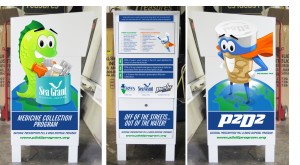Just Add Water

Originally appears in the Winter 2013-2014 issue
Surrounded by big buildings representing even bigger ideas, the students from Pontiac Township High School made their way into the boardroom of the American Medical Association in downtown Chicago and prepared to address the adults poised with notebooks and laptops. On this occasion, the group was taking their ground-breaking program to new heights by addressing the question, “What does one do with unused medication?” Dazzled by the cityscape and excited by the invitation, the students proceeded to their microphones and presented the Prescription Pill and Drug Disposal Program (P2D2), a collaborative effort between communities, local pharmacies, police departments, hospitals, city officials, students, and more. By demonstrating their concern about the integrity of the water supply, the student-created P2D2 program has gained international attention for its curricular innovations and eco-conscious applications, inspiring dozens of similar programs in Illinois, twenty-six other U.S. states, and other countries.
Research studies have uncovered startling statistics about the variety of drugs in our water supply. A simple drink of tap water can contain trace amounts of chemicals found in everything from to birth control pills to cholesterol lowering medication. Armed with research, Pontiac students set out in 2007 to make a difference. Though they realized that prescription drugs would continue to find their way into the water supply through human waste, the students hoped to make a major dent in the problem by changing the way people dispose of ingestible chemicals.
The following years demonstrated phenomenal results. Not only have they changed the way Illinois and other states now dispose of unused and unwanted prescription medication and controlled substances, our students have created public awareness about contaminated drinking water. In the process, they have also showcased ways that students everywhere can be galvanized to unexpected levels of achievement. The scene in Chicago was far from the peak of their success. As more and more teachers and communities adopt the program, the full potential for this eco-curriculum has yet to be realized.
Developing a successful P2D2 program hinges on student investment. Unless the students buy into the program, the curriculum becomes merely another assignment. However, as our school’s experience has shown, a grassroots passion for conservation can achieve international results. In what follows, I’ll explain how P2D2 works, include some advice on starting a P2D2 program in your community, and share a few examples of the curriculum we developed as part of our project at Pontiac.
To view the photo-rich magazine version, click here.
If you are not already a subscriber, please subscribe to read the full article
Michael Soares is a doctoral student in English Education at Illinois State University and an English teacher at Pontiac Township High School in Illinois. He is the editor for the P2D2 program and can be reached at soaresm@pontiac.k12.il.us.
Leave a Reply
You must be logged in to post a comment.










